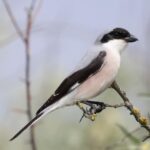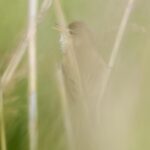A Private Tour today, down in the Norfolk Broads. Given all the good weather this summer, it was disappointing that the day we were to go out was one of the few with rain forecast. Still it stayed dry all morning and the heavy rain helpfully held off until we had almost finished. It didn’t put us off getting out anyway, and we had a nice day out.
Having met in Wroxham, we headed over to Potter Heigham marshes to start the morning. Several of the pools have largely dried out over the summer, but some still have water in them. We headed straight down to the corner and up onto the bank so we could see over the reeds.
On the first pool we checked, there were several Ruff feeding around the muddy edges of the water, all in grey-brown non-breeding plumage now. A Green Sandpiper flew in calling and dropped down on the mud too.
There were lots of ducks, mostly asleep on the drier islands, mainly Mallard and Gadwall plus a few Teal, all in drab eclipse plumage now, as well as several Greylags and Egyptian Geese. We checked through the ducks carefully, but there was no sign of any Garganey with these ones. This is a good site for Garganey and they probably breed here, although it is very hard to prove for sure. Several Little Grebes were out on the water.
Moving on to the next pool round, there were more waders here, mainly Lapwings and Ruff. We could hear a Greenshank calling in the distance, and we found another one feeding here. It was joined by a Spotted Redshank, a dusky grey-brown juvenile. Through the scope, we could see its long needle-fine bill.

Two Ringed Plovers dropped in on one of the muddy islands. A Common Snipe was feeding at the back, against the reeds, probing vigorously in the mud with its long bill, and a Water Rail appeared just behind it from out of the reeds. Two Sedge Warblers were working their way along the back edge of the reeds too – we could see their bold white superciliums through the scope.
As we carried on round, we looked across to see two Kestrels hovering over the grazing marshes, with a third perched in a dead tree nearby. A young Marsh Harrier circled low over the reeds beyond, dark chocolate brown with a contrasting golden orange head, and two Common Buzzards appeared above the wood in the distance.
There were lots of hirundines feeding out over the pools, Swallows and House Martins, presumably gathering to feed up before they look to depart for Africa for the winter. As we walked along the river bank, we heard some of the Swallows alarm calling and looked up to see a Hobby shooting past, before heading away over the river.
There were more waders on the pools on this side. We found several more Spotted Redshanks, all juveniles, and Green Sandpipers. Two more Greenshanks flew off calling. A single Black-tailed Godwit was feeding in the deeper water on one of the pools.
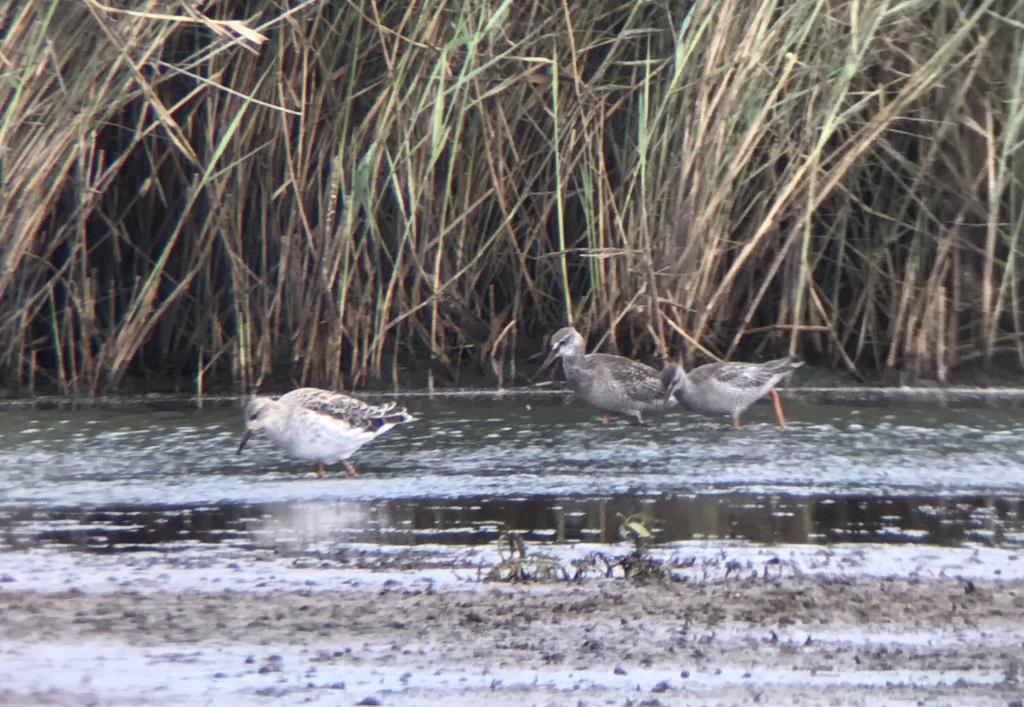
Several Tufted Duck and a Common Pochard were nice additions for the day’s list. A couple of Cormorants were drying their wings on one of the islands. Two Yellow Wagtails flew up from behind reeds but dropped down again quickly, before everyone could get onto them.
When we got to the last of the pools, we turned to walk back. We still hadn’t found a Garganey, so we stopped to have another look through the ducks on the way. Three smaller ducks were asleep on the bank at the back of one of the pools. Two were Teal, but the third was a bit larger and even though it had its bill tucked in we could see it had a bolder pale supercilium stretching behind the eye, a Garganey.
Even though it was dry this morning, it was still rather cool and breezy. There were not many insects to see today, given the weather, but we did find a nice male Ruddy Darter basking on the path out of the wind on our way back.
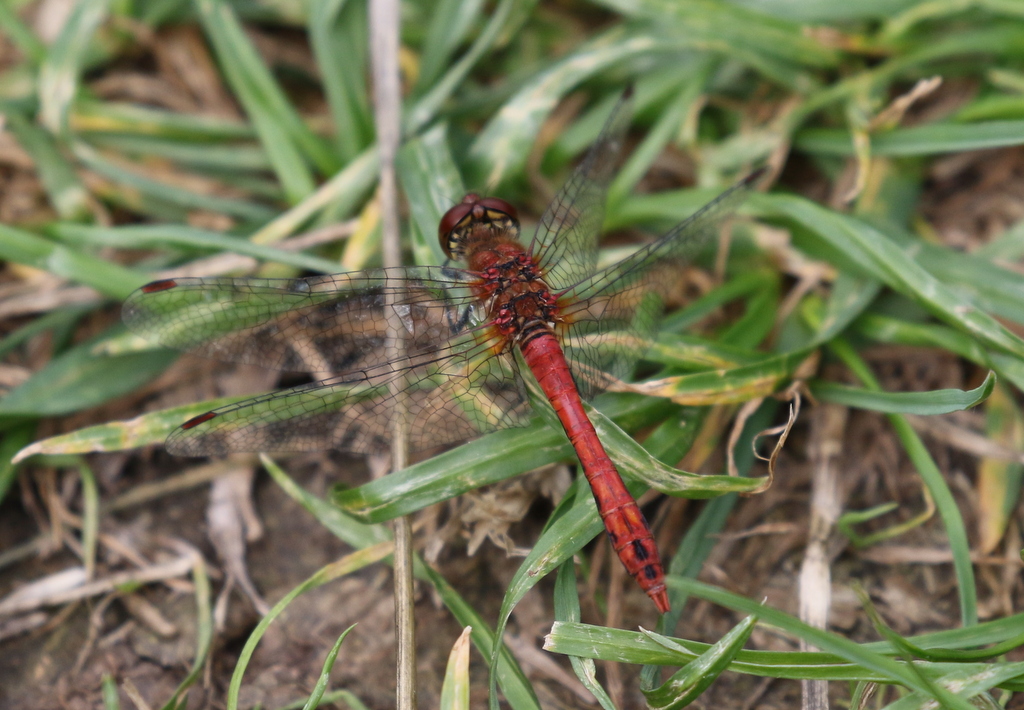
Our next destination was Buckenham Marshes, over in the Yare Valley. When we got out of the car, it was now starting to spit with rain, though thankfully not enough to stop us exploring.
The walk down along the access track towards the river was fairly quiet until we got nearer to the far end. A young Chinese Water Deer appeared in the middle of the grazing marsh. It ran a short distance, then stopped to look around. When it set off again, it ran straight towards us, stopping just the other side of the ditch and looking at us from behind some vegetation, before speeding away across the grass. Two Red Kites circled up over the wood on the other side of the river.
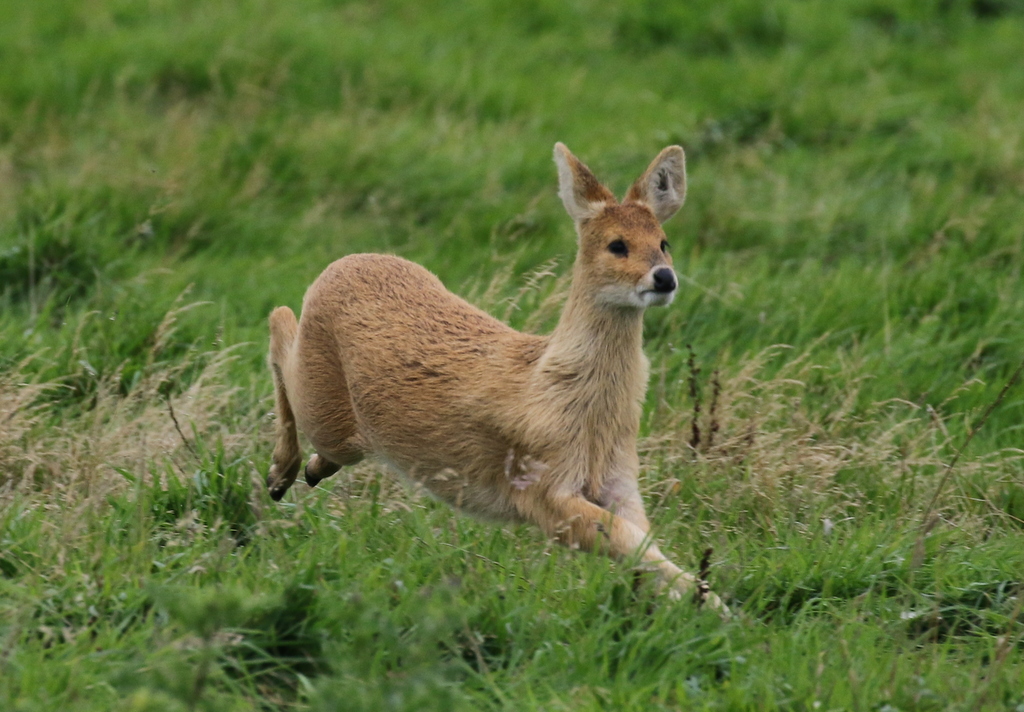
As we carried on towards the river, we stopped several times to scan the pool at far end. There were lots of Lapwings hiding in the vegetation around the edges and several Ruff feeding in the shallows. Two juvenile Dunlin, with black-spotted belly patches, were picking around on a muddy strip in the middle. A careful scan revealed several Common Snipe around the margins, but we couldn’t find the Wood Sandpiper which has been here for the last couple of days.
There have been some Whinchats here too, but we couldn’t find those either as we walked out, and we presumed they were keeping down out of the wind. We found a sheltered spot in the lee of the hide at the end and quickly located one of the Whinchats on the fence below the river bank. We got it in the scope and had a good look at it, noting its bold pale supercilium, before it dropped down out into the grass out of view.

While we were scanning the pool from here, one of the group spotted some small birds down in the short vegetation out in the middle of the grazing marsh, where it had been mown. A smart male Stonechat was perched on a small stem and eventually two streaky juvenile Stonechats appeared out of the grass close to it.
The birds were feeding down on the ground in a damp depression in the field, so they were hard to see, but at least one Whinchat eventually appeared in the vegetation with the Stonechats. Eventually they all flew up out of the grass and landed on the taller thistles on the next block of grazing marsh which had not been cut. Now we could see there were actually three Whinchats here.
While we were watching the Whinchats, a small wader appeared down at the front corner of the pool. Through the scope, we could see it was the Wood Sandpiper – it had presumably been feeding behind the taller vegetation along the front edge, where we couldn’t see it. We had a good look at it through the scope, noting its pale spangled upperparts and bold pale supercilium, before it disappeared again.
We made our way back to the car and headed round to the reserve at Strumpshaw Fen for lunch next. We could hear Long-tailed Tits and a Chiffchaff calling in the car park when we arrived. On our way to Reception Hide, we stopped to look at the Feeders. A steady stream of tits were coming and going constantly, including one or two Marsh Tits and a Coal Tit too.

We ate our lunch in Reception Hide, looking out over the pool in front. There were lots of ducks here, once again all in eclipse, and the resident Black Swan was feeding out in the middle. After lunch, we headed out onto the reserve. It was spitting with rain now, but it was thankfully still light.
There was not much to see immediately from Fen Hide when we arrived. Two Grey Herons flew in and a lone Teal landed in the middle of the water, standing motionless for a couple of minutes looking nervous, before flying off again. Scanning the cut reeds below the hide carefully, we found three Common Snipe hiding in the vegetation. They were very well camouflaged and hard to see until two of them started feeding.

As we carried on round to Tower Hide, a Great Crested Grebe was swimming on the river, still looking smart in breeding plumage. Looking out over the pools in the reeds on the way, we spooked several large flocks of mainly Gadwall. A Green Sandpiper flew off with one group.
There were lots more ducks from the hide, particularly a good number of Shoveler. Even though they are all in brown eclipse plumage, their distinctive large bills still give them away instantly. There were several Ruff feeding around the muddy edges, and a few Lapwings.
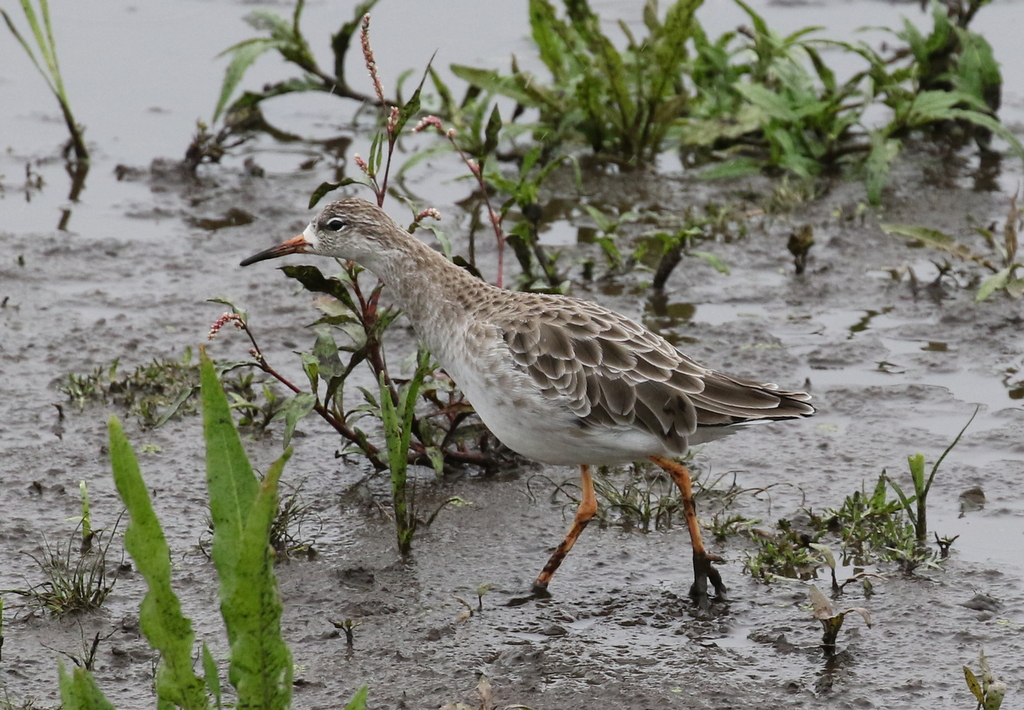
Three juvenile Marsh Harriers circled up out in the reedbed, despite the rain. They seemed to be playing, chasing each other.
There were several Grey Herons around the pool and we had literally just remarked that we had not seen any sign of one the Great White Egrets which have been here in recent days when one of them flew up out of the reeds. It flew back away from us at first, then circled round, giving us a good view of its long yellow bill, before it dropped down into the reeds again.
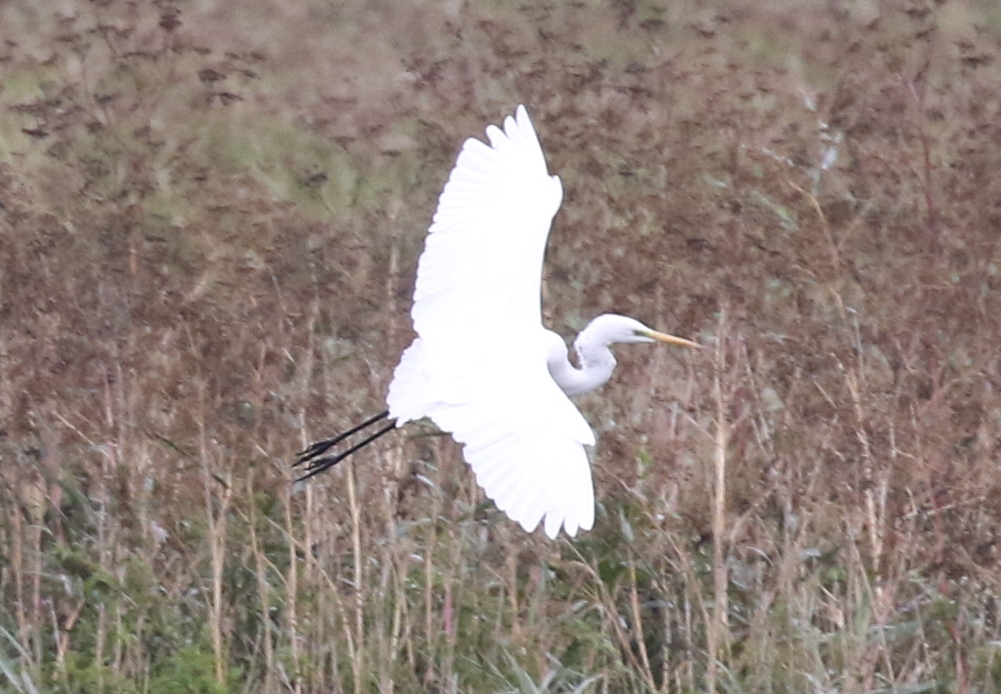
With a couple more places we wanted to visit this afternoon, we headed back to the car and drove round to Ormesby Little Broad. The rain was picking up now, and as we walked out along the nature trail towards the broad it was all quiet in the trees. We had a quick look out at the broad from the platform at the end, which held several large rafts of Coot and a few Great Crested Grebes. We didn’t linger here though and on the walk back a Treecreeper was calling from somewhere in the trees.
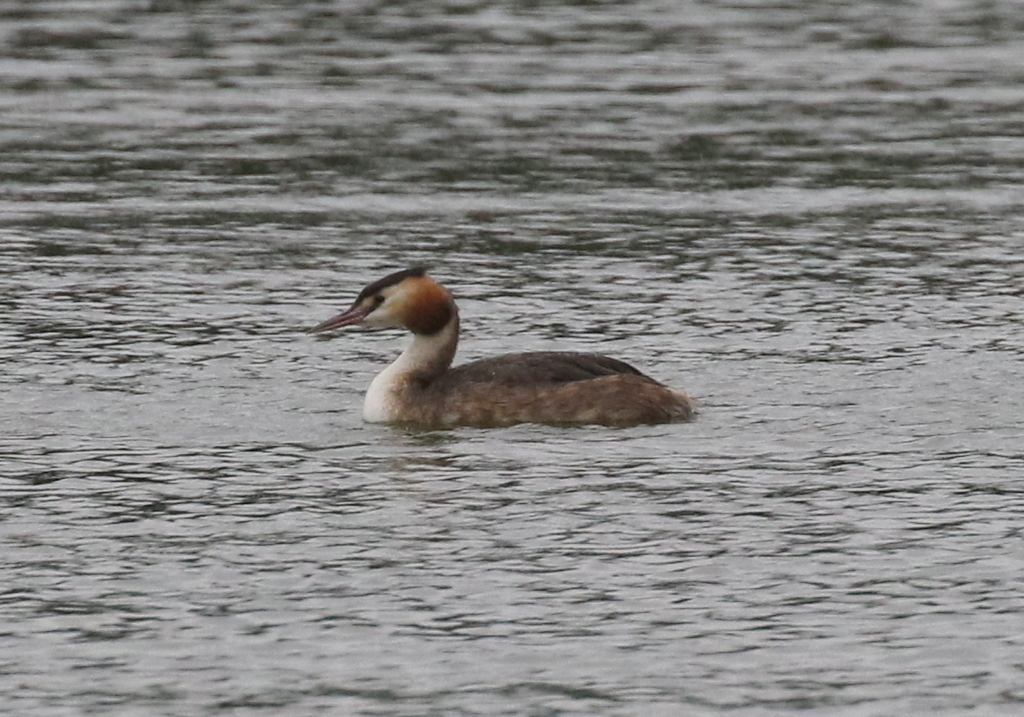
Our last stop was at Rollesby Broad. Thankfully we didn’t have far to walk here – we could see the broad from the car park – but unfortunately it was now drizzling harder, blowing towards us, and visibility out across the water was poor.
We could see several terns in the mist right at the far end, but they were very hard to make out clearly against the reeds and trees. Two or three pale silvery grey Common Terns stood out, but there seemed to be two or three smaller, darker birds with them. At one point, two of them circled up above the tree line and we were able to confirm they were Black Terns, but they were still not easy for everyone to see.
Thankfully one of the Black Terns then came up to our end of the broad, and we could see it properly. It was a juvenile – with sooty grey upperparts, darker on the mantle, and a black cap. Despite the weather, we could see it was flying much more buoyantly, dipping down to the water’s surface to pick for food. When it made its way back down the broad, we headed back to the car.
It was time to call it a day now – we had enjoyed a very successful day in the Broads and the weather could do its worst now.
